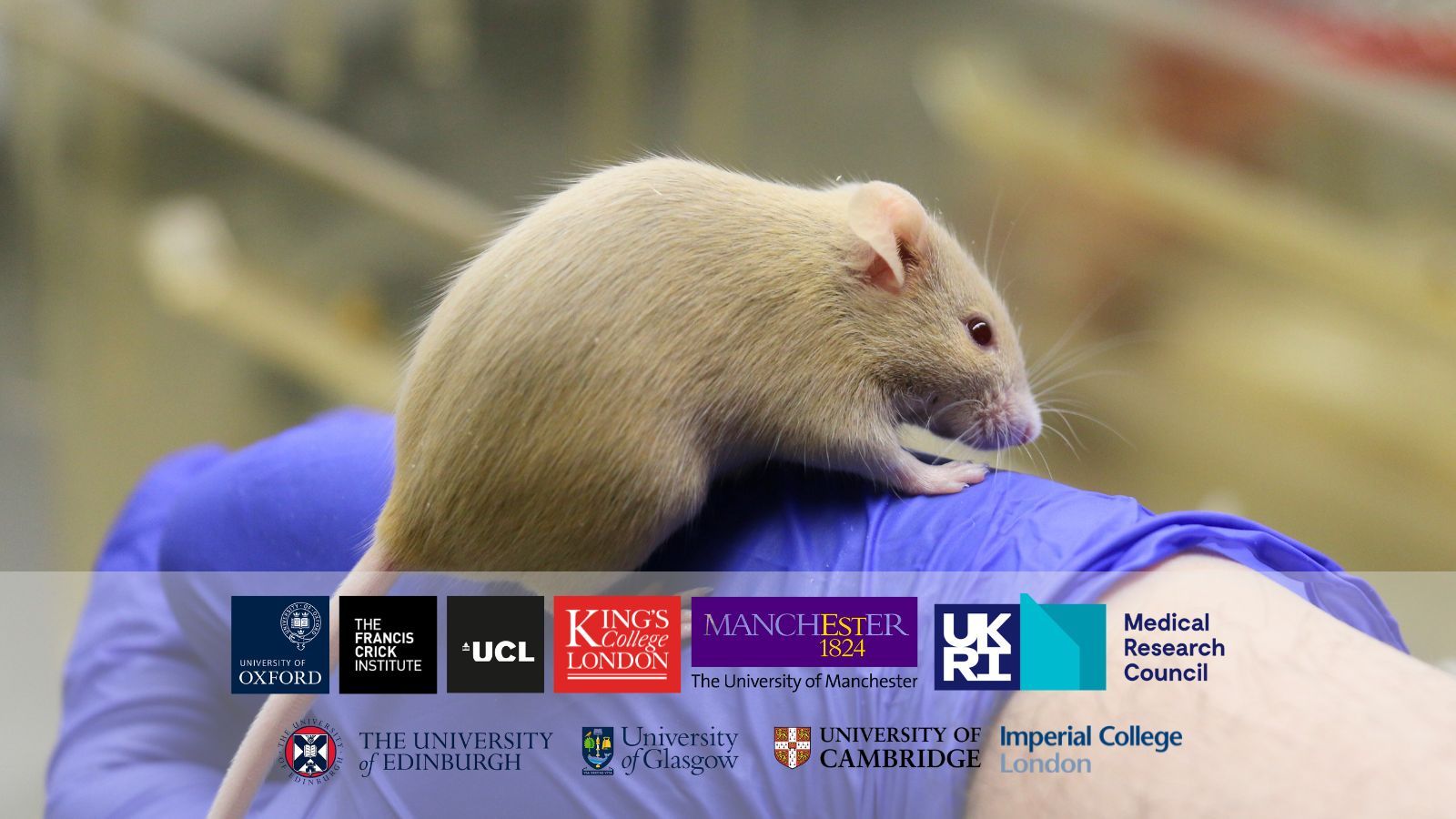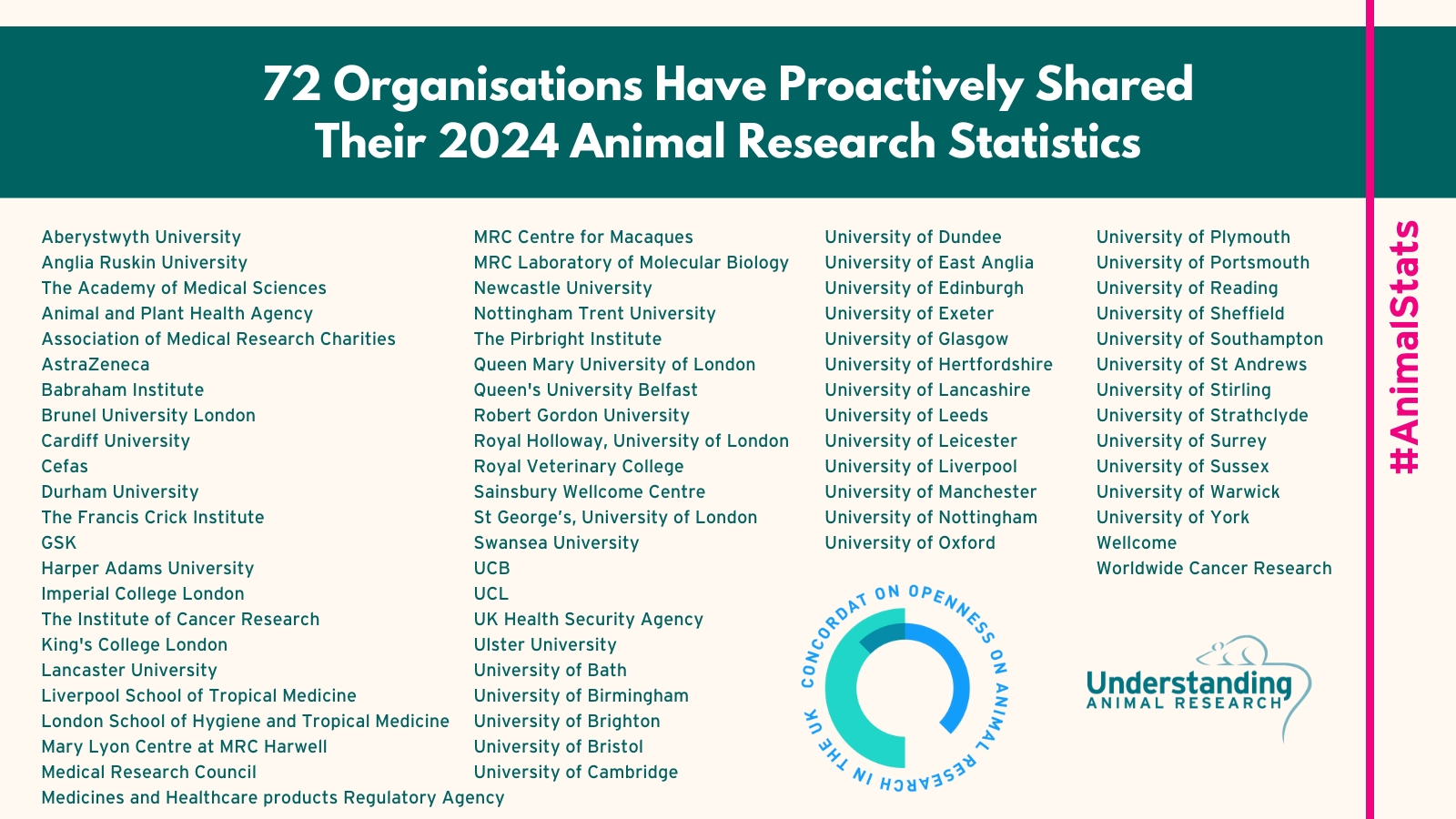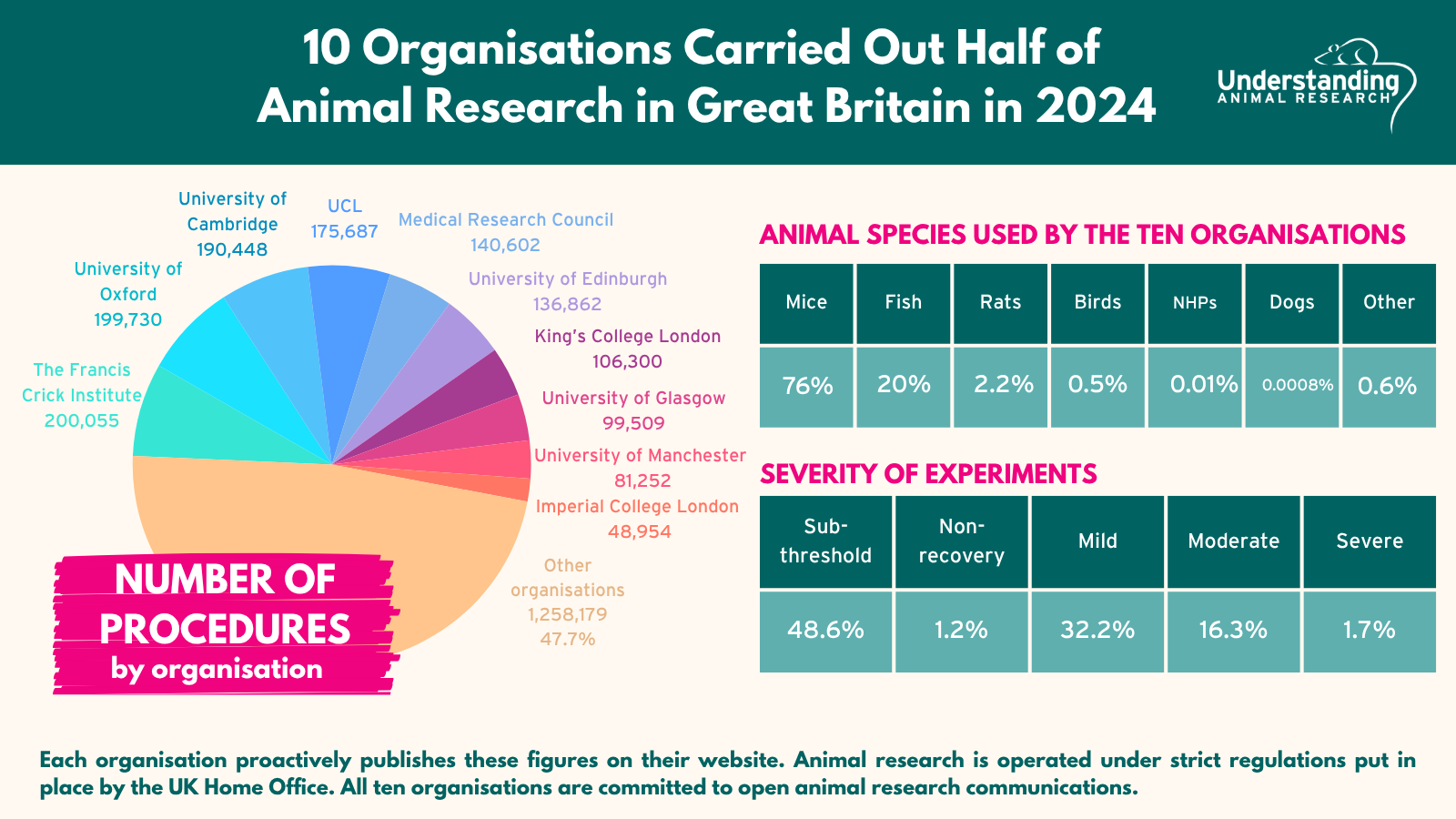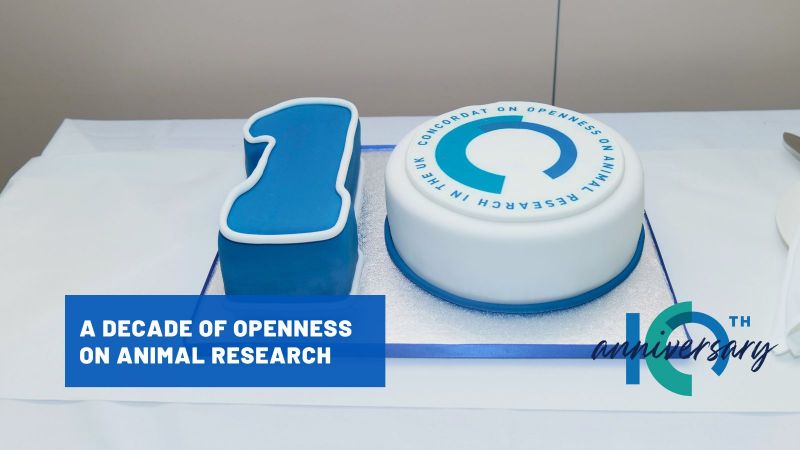
Ten organisations account for half of all animal research in Great Britain in 2024
-
99% of procedures carried out in mice, fish, rats, and birds
-
82% of procedures caused pain equivalent to, or less than, an injection
-
72 research institutions and funders have proactively shared their 2024 animal research statistics
Download "10 organisations carried out half of animal research in Great Britain in 2024"
Today, 23 October 2025, Understanding Animal Research (UAR) has published a list of the ten organisations that carried out the highest number of animal procedures – those used in medical, veterinary, and scientific research – in Great Britain in 2024. These statistics are freely available on the organisations’ websites as part of their ongoing commitment to transparency and openness around the use of animals in research.
This list coincides with the publication of the Home Office’s report on the statistics of scientific procedures on living animals in Great Britain in 2024.
The ten listed organisations were responsible for 1,379,399 procedures, 52% (more than half) of the 2,637,578 procedures carried out on animals for scientific research in Great Britain in 2024*. Of these 1,379,399 procedures, more than 99% were carried out on mice, fish, rats, and birds and 82% were classified as causing pain equivalent to, or less than, an injection.
The ten organisations are listed below alongside the total number of procedures they carried out in 2024. Each organisation’s name links to its animal research webpage, which includes more detailed statistics. Case studies explaining how animal research has been used in recent medical research are also provided in the Notes to Editors section. This is the tenth consecutive year that organisations have come together to publicise their collective statistics and examples of their research.
|
Organisation |
Number of Procedures (2024) |
|
200,055 |
|
|
199,730 |
|
|
190,448 |
|
|
175,687 |
|
|
140,602 |
|
|
136,862 |
|
|
106,300 |
|
|
99,509 |
|
|
81,252 |
|
|
48,954 |
|
|
TOTAL |
1,379,399 |
Seventy-two organisations have proactively published their 2024 animal research statistics

UAR has also produced a list (see appendix) of 72 organisations in the UK that have publicly shared their 2024 animal research statistics. This includes organisations that carry out or fund animal research.
All organisations are committed to the ethical framework called the ‘3Rs’ of replacement, reduction and refinement. This means avoiding or replacing the use of animals where possible, minimising the number of animals used per experiment and optimising the experience of the animals to improve animal welfare. However, as institutions expand and conduct more research, the total number of animals used can rise even if fewer animals are used per study.
All organisations listed are signatories to the Concordat on Openness on Animal Research in the UK, which commits them to being more open about the use of animals in scientific, medical and veterinary research in the UK. More than 130 organisations have signed the Concordat, including UK universities, medical research charities, research funders, learned societies and commercial research organisations.
Wendy Jarrett, Chief Executive of Understanding Animal Research, which developed the Concordat on Openness, said:
“Animal research remains a small but vital part of the quest for new medicines, vaccines and treatments for humans and animals. Alternative methods are increasingly being phased in, but, until we have sufficient reliable alternatives available, it is important that organisations that use animals in research maintain the public’s trust in them. By providing this level of information about the numbers of animals used, and the experience of those animals, as well as details of the medical breakthroughs that derive from this research, these Concordat signatories are helping the public to make up their own minds about how they feel about the use of animals in scientific research in Great Britain.”
Sarah Hart-Johnson, Director of the Biological Research Facility at the Francis Crick Institute, said:
“The Crick remains committed to openness in animal research, and these statistics give an insight into our scientific activity each year. Our numbers are consistent with an increase in research into the complex biological systems that lead to debilitating human diseases, such as infections, cancer progression and organ development. All research programmes involving animals begin with the use of non-animal methods, and only when a scientific question cannot be answered by an alternative technology do we use animal models. We uphold the 3Rs principles to replace animal research wherever we can, reduce the number of animals needed for meaningful results and refine experiments to enhance wellbeing."
James Bussell, Director of Biomedical Services at the University of Oxford, said:
“Researchers across Oxford University are constantly exploring new technologies that will reduce our dependence on animals for research, but in the meantime, research involving animals continues to play a small but important part in a broad range of biomedical research.
“We continually strive to maintain the highest possible standards of welfare for those animals that we do use and ensure that all research involving animals is strictly controlled and monitored.”
Professor Jon Simons, Head of the School of Biological Sciences at the University of Cambridge, said:
"Animal research remains critical for understanding complex biological systems and is an essential step in the development of new medicines, vaccines and treatments for both humans and animals. We are committed to continuing to reduce the number of animals used in biomedical research, and our scientists are actively working on new methods and techniques that will provide robust scientific alternatives.”
Professor Geraint Rees, UCL Vice-Provost (Research, Innovation & Global Engagement), said:
"Biomedical research at UCL can change people's lives for the better as we address some of the most pressing problems in global health, and we couldn't do it without animal research that has contributed to groundbreaking advances in treating cancer, neurodegenerative diseases, and more. Our scientists use animals in their research only when strictly necessary, while developing innovative new ways to reduce the need for animals in their labs, to minimise harm, and to maximise the potential impact of our research."
Dr Glenn Wells, Deputy Executive Chair of the Medical Research Council, said:
“The MRC funds world-leading research to improve human health and develop new treatments.
“Animal studies have been essential to many breakthroughs, including recent research showing that blocking a protein called IL-11 – which drives inflammation and tissue scarring – could extend healthy lifespan and reduce age-related conditions such as heart disease, diabetes and cancer.
“All MRC-funded research involving animals follows the highest standards of welfare and is guided by the principles of replacing, refining and reducing the use of animals wherever possible.
“We uphold UK Research and Innovation’s position on the responsible use of animals in research and our policy that improves protections for animals, ensures reproducibility, and supports researchers whose work involves animals.”
Professor Catherine Martin, Vice-Principal Corporate Services, University of Edinburgh, said:
“Research involving animals continues to play a small but important role in research at the University of Edinburgh to improve understanding of health and disease in people and animals. The University takes an active role in developing alternative approaches to reduce, refine and replace the use of animals, to optimise the quality of the work we undertake while minimising effects on the animals concerned. The number of animals used in research at Edinburgh has continued on a reducing trajectory, with fewer and less severe procedures carried out in 2024 than in 2023.”
Dr Julie Keeble, Director of Biological Services, King's College London, said:
“We continue to support world class research involving animals that prioritises animal welfare. Every experiment is reviewed at multiple levels to ensure that the best outcomes can be achieved for science and welfare. We see excellent research impacts from studies involving animals but continually reinforce and facilitate the replacement, reduction and refinement of the use of animals for scientific purposes.”
David Duncan, University of Glasgow Chief Operating Officer, said:
“Research using animals makes an important contribution to the treatment and cure of major human diseases and viruses, including cancers, Alzheimer’s Disease, flu and COVID-19. At the University of Glasgow animals are used in research only where it is essential, and we remain dedicated to the principles of reduction, refinement, and replacement.
“The University is committed to the development of alternative methods – such as computer modelling, tissue culture, cell and molecular biology, and research with human material – but some work involving animals must continue for further advances in medical sciences to be made. All research undertaken on animals is conducted under strict ethical and welfare guidelines, under licence by the Home Office.”
Dr. Maria Kamper, Director of the Biological Services Facility at The University of Manchester, said:
"Scientific research involving animals remains essential in advancing our understanding of health and disease, and is fundamental to developing new medicines and medical technologies.
"At our institution, we prioritize transparency in animal research alongside a culture of exceptional care among our staff. Our approach is founded on collaboration and superior animal husbandry standards. We are dedicated to cultivating a sustainable environment where animal welfare, staff wellbeing, scientific excellence, and open communication with both stakeholders and the public are our highest priorities.
"This dedication aligns with the University of Manchester's broader mission to enhance education, knowledge, and wisdom for society's benefit."
Professor Marina Botto, Director of Bioservices at Imperial College London, said:
"Animal models remain a vital part of Imperial medical research, helping researchers to uncover groundbreaking insights into dementia, aging, gut health, cancer and sleep. We continue to champion the 3Rs across our community and use alternative models where possible, at every stage of research. Our 3Rs Hub is the hallmark of our commitment and serves as a central resource, offering Imperial staff, students, and external partners easy access to tools and information to support the integration of the 3Rs in their work."
-Ends-
Notes to Editors
For more information, contact Hannah Hobson on hhobson@uar.org.uk.
The hashtag for social media is #AnimalStats.
Understanding Animal Research (UAR) is a not-for-profit organisation that explains how and why animals are used in scientific research in the UK. Our supporters include government agencies, scientific societies, universities, veterinary schools, research funding bodies, commercial organisations and charities. Our supporters both use animals and lead the development of non-animal methods.
A list of recent animal research case studies from contributing organisations can be found below.
Further information on the Concordat on Openness on Animal Research in the UK can be found here: http://concordatopenness.org.uk
These figures refer to procedures using animals for medical, veterinary, or scientific research, as licensed by the UK’s Home Office under the Animals (Scientific Procedures) Act 1986. The use of animals to test tobacco products was banned in the UK in 1997 and it has been illegal to use animals to test cosmetic products in this country since 1998. A policy ban on household product testing using animals was introduced in 2010. Since 2013, it has been illegal to sell or import cosmetics anywhere in the UK or the EU where the finished product or its ingredients have been tested on animals.
*The Home Office recorded 2,637,578 completed procedures for Great Britain in 2024, 1,379,399 (52%) of which were carried out at these ten organisations.
https://www.gov.uk/government/statistics/scientific-procedures-on-living-animals-great-britain-2024
Full table of procedures broken down by species from the top ten organisations:
|
Organisation |
Total Procedures (2024) |
Mice |
Fish |
Rats |
Birds |
Dogs |
Monkeys |
Other animals |
|
The Francis Crick Institute |
200,055 |
183,643 |
15,933 |
|
|
|
|
479 |
|
University of Oxford |
199,730 |
191,987 |
6,978 |
404 |
75 |
|
8 |
278 |
|
University of Cambridge |
190,448 |
146,964 |
38,288 |
4,658 |
|
|
34 |
504 |
|
UCL |
175,687 |
105,810 |
67,910 |
1,401 |
|
|
|
566 |
|
Medical Research Council |
140,602 |
140,537 |
|
37 |
|
|
28 |
|
|
University of Edinburgh |
136,862 |
78,286 |
43,760 |
9,598 |
3,473 |
|
|
1,745 |
|
King's College London |
106,300 |
82,142 |
21,957 |
2,096 |
|
|
|
105 |
|
University of Glasgow |
99,509 |
91,199 |
5,992 |
1,020 |
831 |
6 |
|
461 |
|
University of Manchester |
81,252 |
58,271 |
19,077 |
1,863 |
|
|
|
2,041 |
|
Imperial College London |
48,954 |
45,286 |
785 |
993 |
1,042 |
|
|
848 |
|
TOTAL |
1,379,399 |
1,124,125 |
220,680 |
22,070 |
5,421 |
6 |
70 |
7,027 |
All numbers represent completed procedures on animals in 2024. The number of procedures carried out using animals will be slightly higher than the number of animals used, as a small number of animals may be used in more than one procedure.
Full table of procedures broken down by severity categories from the top ten organisations:
|
Organisation |
Sub-Threshold |
Non-Recovery |
Mild |
Moderate |
Severe |
Total Procedures (2024) |
|
The Francis Crick Institute |
143,291 |
653 |
27,170 |
27,747 |
1,194 |
200,055 |
|
University of Oxford |
122,037 |
1,425 |
47,773 |
26,760 |
1,735 |
199,730 |
|
University of Cambridge |
64,934 |
1,064 |
80,640 |
40,420 |
3,390 |
190,448 |
|
UCL |
56,905 |
3,919 |
80,171 |
33,923 |
769 |
175,687 |
|
Medical Research Council |
104,065 |
1,365 |
24,643 |
5,860 |
4,669 |
140,602 |
|
University of Edinburgh |
80,754 |
2,558 |
36,751 |
15,283 |
1,516 |
136,862 |
|
King's College London |
47,715 |
1,497 |
37,347 |
18,012 |
1,729 |
106,300 |
|
University of Glasgow |
57,789 |
421 |
23,222 |
17,187 |
890 |
99,509 |
|
University of Manchester |
45,699 |
630 |
17,711 |
14,763 |
2,448 |
81,252 |
|
Imperial College London |
18,084 |
394 |
14,907 |
14,572 |
997 |
48,954 |
|
TOTAL |
741,273 (53.7%) |
13,926 (1.0%) |
390,335 (28.3%) |
214,527 (15.6%) |
19,337 (1.4%) |
1,379,398 |
Examples of severity
Severity assessments measure the harm experienced by an animal during a procedure. A procedure can be as mild as an injection, or as severe as an organ transplant. Severity assessments reflect the peak severity of the entire procedure and are classified into five different categories:
Sub-threshold: When a procedure did not cause suffering above the threshold for regulation, i.e. it was less than the level of pain, suffering, distress or lasting harm that is caused by inserting a hypodermic needle according to good veterinary practice.
Non-recovery: When the entire procedure takes place under general anaesthetic and the animal is humanely killed before waking up.
Mild: Any pain or suffering experienced was only slight or transitory and minor so that the animal returns to its normal state within a short period of time. For example, the equivalent of an injection or having a blood sample taken.
Moderate: The procedure caused a significant and easily detectable disturbance to an animal’s normal state, but this was not life threatening. For example, surgery carried out under general anaesthesia followed by painkillers during recovery.
Severe: The procedure caused a major departure from the animal’s usual state of health and well-being. This would usually include long-term disease processes where assistance with normal activities such as feeding and drinking were required, or where significant deficits in behaviours/activities persist. Animals found dead are commonly classified as severe as pre-mortality suffering often cannot be assessed.
List of 72 UK organisations that have shared their 2024 animal research statistics:
Aberystwyth University
Anglia Ruskin University
The Academy of Medical Sciences
Animal and Plant Health Agency
Association of Medical Research Charities
AstraZeneca
Babraham Institute
Brunel University London
Cardiff University
Cefas
Durham University
The Francis Crick Institute
GSK
Harper Adams University
Imperial College London
The Institute of Cancer Research
King's College London
Lancaster University
Liverpool School of Tropical Medicine
London School of Hygiene and Tropical Medicine
Mary Lyon Centre at MRC Harwell
Medical Research Council
Medicines and Healthcare products Regulatory Agency
MRC Centre for Macaques
MRC Laboratory of Molecular Biology
Newcastle University
Nottingham Trent University
The Pirbright Institute
Queen Mary University of London
Queen's University Belfast
Robert Gordon University
Royal Holloway, University of London
Royal Veterinary College
Sainsbury Wellcome Centre
St George’s, University of London
Swansea University
UCB
UCL
UK Health Security Agency
Ulster University
University of Bath
University of Birmingham
University of Brighton
University of Bristol
University of Cambridge
University of Dundee
University of East Anglia
University of Edinburgh
University of Exeter
University of Glasgow
University of Hertfordshire
University of Lancashire
University of Leeds
University of Leicester
University of Liverpool
University of Manchester
University of Nottingham
University of Oxford
University of Plymouth
University of Portsmouth
University of Reading
University of Sheffield
University of Southampton
University of St Andrews
University of Stirling
University of Strathclyde
University of Surrey
University of Sussex
University of Warwick
University of York
Wellcome
Worldwide Cancer Research
CASE STUDIES
The Francis Crick Institute
How to block cancer’s elusive growth switch
Julian Downward, head of the Oncogene Biology Laboratory, works on a major cancer-driving gene called RAS, which is mutated in around one in five cancers and was once referred to as ‘undruggable’. His lab decided to focus on a particular enzyme that RAS targets, called PI3K, hoping to stop uncontrolled cancer growth while maintaining the function of RAS in healthy cells.
As reported in a paper in Science, Julian worked with biotechnology company Vividion Therapeutics, who first used chemical screening to find a series of small compounds that might stop the RAS-PI3K interaction without blocking PI3K's other functions. Julian's team then tested the compounds developed by Vividion in mice with RAS-mutated lung tumours, finding that the treatment effectively halted tumour growth, with no evidence of hyperglycaemia, which is a problem for current drugs on the market. It also slowed tumour growth in mice with HER2 mutations, a cancer-driving gene commonly overexpressed in breast cancer.
The candidate drug has now entered the first clinical trial in humans to test for safety and side effects in people with RAS and HER2 mutations, which wouldn't have been possible without years of discovery research in the lab.
https://www.crick.ac.uk/news/2025-10-09_how-to-block-cancers-elusive-growth-switch
University of Oxford
A research team jointly led by the University of Oxford has discovered that the mechanical environment surrounding a tumour can cause cancer cells to change their behaviour, triggering a switch from rapid growth to a more invasive, drug-resistant state.
Cancer cells are notoriously flexible, and take on new features as they move around the body. Many of these changes are due to epigenetic modifications – the way DNA is packaged – and not due to mutations in the DNA itself. These modifications are difficult to target because they are reversible, and can flip on and off.
Using a zebrafish model of melanoma, the researchers showed that when tumour cells are tightly confined by surrounding tissues, they undergo structural and functional changes. Rather than continuing to divide rapidly, the cells activate a program of ‘neuronal invasion’, enabling them to migrate and spread into the surrounding tissue.
The findings highlight the role of the tumour microenvironment in shaping cancer cell behaviour, showing how physical cues can drive cells to reorganise their cytoskeleton, nucleus and chromatin architecture in order to shift between states of growth and invasion. Crucially, the study also demonstrates how physical stress can act as a potent and underappreciated driver of epigenetic change.
https://www.ox.ac.uk/news/2025-08-28-pressure-flips-switch-cancer-cells
The full paper, ‘Mechanical confinement governs phenotypic plasticity in melanoma', is published in Nature.
University of Cambridge
Mice are vital in the search for effective new dementia treatments
“Dementia has often been viewed as something that happens normally as people age, but it's not. It's a disease that we need to treat, so that people can live well and stay independent in later life,” says David Harrison. “But many pharmaceutical companies have lost confidence in working in this area because the risk of failure is too great.” With expertise in drug discovery, Harrison’s team at Cambridge’s ALBORADA Drug Discovery Institute is designing and making chemical molecules - the basis of future drugs - and testing whether they work on novel targets in the body. The aim is to develop these ideas to the point where pharmaceutical partners can more confidently take things forward.
While the team routinely uses test-tube and computer-based models, animal models are vital in understanding how the many different cell types in the brain interact together in disease.
They’re also vital in understanding how potential drugs are metabolised and distributed throughout the body, and in looking for any adverse effects that may occur in other tissues.
Harrison says: “Almost one million people are estimated to be living with dementia in the UK. We need to find better treatment options. The animals we use are an essential part of the drug discovery process - they could help us change people’s lives.”
https://www.cam.ac.uk/stories/mice-are-vital-in-dementia-research
UCL
Blocking brain damage may slow growth of brain cancer
Blocking brain damage triggered by a glioblastoma, an aggressive brain cancer, may slow the growth of the cancer and allow the brain to keep working better for longer, according to new research in mice led by UCL researchers.
The study, published in Nature in August, found that early-stage tumours damaged parts of nerve cells called axons, and that the mouse brain’s natural response to this injury – breaking down and clearing away these damaged axons – accelerated the tumour’s growth.
Mice in whom this natural response was turned off, by deactivating the SARM1 gene, developed less aggressive tumours, lived for longer and maintained normal brain function that persisted to nearly the end of their lives. In contrast, mice whose brains responded to nerve damage as normal developed more aggressive tumours and progressive disability, the researchers found.
Drugs that block this response, by targeting SARM1, the protein that destroys damaged axons, are already being developed for early phase trials in neurodegenerative conditions in which axons are also damaged, such as traumatic brain injury and motor neuron disease. The researchers say that while more lab work is still needed, they hope to one day test such drugs in people with glioblastoma.
The average survival time after diagnosis of glioblastoma is about 12-18 months, even with the current best treatment. The researchers, based in the UCL Cancer Institute, say they hope their research could lead to a new way to delay or even prevent glioblastomas from progressing.
https://www.ucl.ac.uk/news/2025/aug/blocking-brain-damage-may-slow-growth-brain-cancer
Medical Research Council
Blocking a single protein could help us live healthier for longer
Scientists at the MRC Laboratory of Medical Sciences, working with Duke-NUS Medical School in Singapore, have discovered that blocking a protein called interleukin-11 (IL-11) can dramatically extend healthy lifespan in mice.
Mice that had the IL-11 gene removed lived more than 20% longer and stayed healthier than normal mice. In another study, middle-aged mice treated with an anti-IL-11 antibody lived up to 25% longer.
They developed fewer cancers and showed fewer signs of ageing, such as muscle loss, inflammation and organ damage. Importantly, the treatment caused very few side effects.
Ageing is a complex process that affects the whole body, and it cannot be studied in cells alone. Using mice allowed researchers to understand how IL-11 drives age-related diseases and to test whether blocking it could improve health in later life.
Anti-IL-11 drugs are already in clinical trials for other conditions, so these findings could open the door to new treatments that help people live not just longer, but healthier lives.
Read more about this research here: Turning off inflammatory protein extends healthy lifespan in mice – UKRI and learn more about the role of IL-11 here: https://www.youtube.com/watch?v=eMsO8MidncA
University of Edinburgh
Scientists at the University of Edinburgh are using new animal models to gain key insights into a rare condition that affects the nervous system of young children.
The condition, known as GRIN2B neurodevelopmental disorder, can cause issues including severe autism, intellectual disability, epilepsy and movement and muscular problems. Sleep disruption is also commonly reported.
There are currently no effective treatments for the condition, which can be devastating for patients and their families and requires lifelong care.
Edinburgh researchers led by Dr Alfredo Gonzalez-Sulser are aiming to help develop new therapeutic strategies and targets for the condition by understanding how mutations in the GRIN2B gene affect animals.
They have developed a new rat model where one copy of the GRIN2B gene has been removed.
Tests have shown that GRIN2B rats, similar to human patients, experience seizures spontaneously. The animals' sleep is also very disrupted, with a clear lack of rapid eye movement (REM) sleep, which is particularly important for cognition and memory.
The team tested the effectiveness of two drugs to block seizures in GRIN2B rats. One was found to block seizures entirely, while the other reduced their duration.
The research shows that the new GRIN2B rat model exhibits key features of the disorder seen in patients, including epilepsy and sleep impairments. The model could therefore help researchers to better understand disease function and test new ways to combat the condition.
https://discovery-brain-sciences.ed.ac.uk/our-staff/research-groups/alfredo-gonzalez-sulser
King’s College London
Asthma is deemed an inflammatory disease, yet the diagnostic and fatal feature is bronchoconstriction, the asthma attack. Our airways are lined with epithelium that act as a barrier to protect us from our environment, including viruses and allergens. We previously discovered a biological process called cell extrusion that removes cells when the epithelium becomes too crowded to preserve proper cell numbers and barrier function. In our work published in Science, we show that during an asthma attack this process of extrusion becomes pathological as the smooth muscle constricts and crowds the barrier, causing too many cells to be removed, damaging the epithelium and resulting in inflammation in an already inflamed lung. Essential to this work was the use of animals, as asthma is a complex disease arising from changes in many cell types and tissues of the lung. The use of thin lung slices from these mice allowed us to visualize the asthma attack live, while at the same time reducing the number of mice needed because many lung slices are obtained from a single mouse, embodying the essence of the 3Rs (replace, reduce, refine). Using mice, we were able to show that drugs that subdue cell extrusion during an asthma attack protected the barrier from damage, and no inflammation ensued, breaking the viscous cycle of attack, wounding, and inflammation.
https://www.kcl.ac.uk/news/discover-limiting-damage-asthma-attack-could-stop-disease
University of Glasgow
Shiga toxin-producing E. coli (STEC) is a significant threat to public health, with an estimated 2.8 million cases globally per year. STEC is most often transmitted by eating contaminated food, or undercooked meat, and produces toxins that can make people very ill, with symptoms including bloody diarrhoea, stomach cramps and fever, lasting up to 14 days. Modern food supply infrastructure and climate change is thought to be increasing the incidence of large, multinational STEC outbreaks.
Treatment options for STEC remain limited and difficult, as antibiotics can make the disease worse by releasing a potent toxin into the infected person’s gut and disrupting beneficial gut bacteria
At the University of Glasgow researchers have taken an important step toward the development of a potential new treatment for STEC. Recent research using mouse models enabled them to show that the use of an antivirulence drug called Aurodox could be an effective treatment. Aurodox works by inhibiting the bacteria from being able to attach to the gut, therefore blocking disease.
The work suggest that Aurodox may influence the gut microbiome in a beneficial way, unlike traditional antibiotics, making it a promising alternative for treating STEC without major disruptions to gut bacteria. Proving the efficacy of Aurodox in mice marks a significant milestone, paving the way for more urgently needed research in this area.
https://www.gla.ac.uk/news/headline_1168023_en.html
University of Manchester
Clotbuster drug is new hope for stroke treatment
A new clotbusting drug tested on mice has been shown by University of Manchester scientists to be significantly better at treating ischemic stroke than existing therapies.
The compound, developed by the scientists and known as caADAMTS13, could be a breakthrough for patients who have brain blood clots with an overabundance of platelets- the tiny cell fragments that help form clots and are often not treatable by existing therapies.
https://www.manchester.ac.uk/about/news/clotbuster-drug-is-new-hope-for-stroke-treatment/
Imperial College London
Drug could improve brain tumour treatment
Imperial College London researchers have discovered a drug which could boost the effectiveness of chemotherapy to treat aggressive brain tumours in adults. Scientists at the Brain Tumour Research Centre of Excellence at Imperial used a drug called daporinad to block production of a chemical which gives cancer cells the high levels of energy they need to grow quickly. This chemical plays a key role in aggressive brain tumours called glioblastoma, where tumours grow and spread very quickly. The team found that the drug boosted the effectiveness of the chemotherapy drug called temozolomide in both tumor cells in the lab and in mouse models. People with glioblastoma live, on average, for just 12-18 months after they are diagnosed and treatments have not changed in 20 years. The discovery could lead to discoveries for new treatment plans or options for people diagnosed with glioblastomas.
https://www.imperial.ac.uk/news/255713/drug-could-boost-chemotherapy-treat-aggressive/
Last edited: 23 October 2025 15:42




